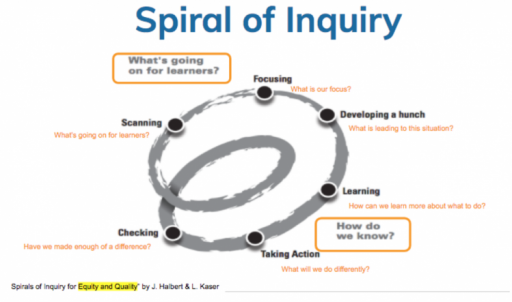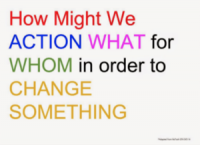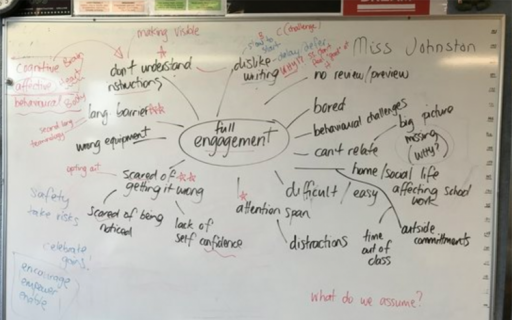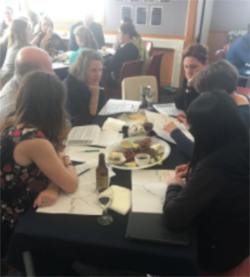Rowan Taigel is the Deputy Principal at Otago Girls' High School.
In this blog Rowan shares her knowledge around collaborative spirals of inquiry drawing on her journey leading this framework at her school.
What is teaching as inquiry?
To me, teaching as inquiry is about examining the conditions and environment we have created for learners, and ensuring they are ideal for learning. To use a gardening analogy; we need to support the growth of the seeds we’ve been given. We can’t exchange them, genetically modify them, or discard them. Not all flowers like direct sunlight and not all like shade. Some need more watering than others. But with the right climate and conditions, each seed can grow to be the best version of itself.
Why use the spiral of inquiry?
Like the teaching as inquiry cycle, the spiral of inquiry is designed to be a continuous cycle of teacher reflection and improvement. As opposed to some forms of action research, you do not have a topic in mind when you start out. You gather data to see what’s going on for your students in order to find the challenges and potential areas of focus that will make the biggest difference for them. The spiral of inquiry is geared towards making sure that your response to student needs is targeted and effective; that it will have an impact and make a difference.
The spiral of inquiry is specifically designed to be collaborative. Having the support of a team enables creative, innovative, and transformational approaches to challenges. The cross-curricular make-up of collaborative inquiry teams at Otago Girls’ High School allows staff to benefit from the rich and varied experiences of different teachers, and the different perspectives and approaches that other subjects’ disciplines can bring to a common challenge.
Using the spirals of inquiry as a framework
There are no hard and fast rules to the spiral of inquiry. While it is natural to read the steps in a clockwise direction, it is important to remember that these are less like phases, and more like “modes” of thinking.
The spiral of inquiry requires a curiosity and evidence-seeking mindset. It requires flexibility and agility in your approach. Once you are familiar and comfortable with the inquiry process, you will find that each part of the spiral framework is something you can dip in and out of as needed. For example, you may switch into hunch mode when working out why something may be happening, switch into scanning mode to go and find more evidence to support or refute your hunch, switch into learning mode to learn more about what strategies you might use to approach your challenge, etc.
The spiral of inquiry is a reliable framework which should underpin your inquiry, not drive it.
Tips about the scanning mode
- It’s important to come at your data collection process with an open mind. Gather all kinds of data from, about, and with your students and their families. Ensure that you focus on students’ wellbeing and engagement alongside academic abilities. This means that data needs to be qualitative (stories, observations, discussions, pastoral) as well as quantitative (test results etc).
- From this information, you should be able to find a pattern or trend in the information that leads you towards an area or aspect that you feel you could focus on to make the biggest difference for your learners.
- In the busy life of a teacher, it can seem painful to be taking so much time in the scanning process. But slowing down to speed up is a real thing! Being thorough and building a picture of the whole student, means that when you have found the specific challenge you need to focus on, you know it is the one that will make the biggest difference for students.
From: A framework for transforming learning in schools: Innovation and the spiral of inquiry
Tips about the focusing mode
- In order to see the greatest impact and improvement, you need to channel your energy into a concentrated focus, rather than dispersing it across many initiatives.
- Spread out all of your scanning data and highlight trends, patterns, surprises and gaps.
- Ask yourself which area could you focus on in order to make the most substantive difference?
- Don’t be afraid to gather a bit more information if you need it. Remember, your students are the experts on themselves, it may just take some careful or inventive question design to gain the insight you need.
- You can summarise your focus by writing an inquiry question.
Inquiry question formula
Here is an example of a brainstorm completed by a group of teachers at Otago Girls’ High School as they adopted a focusing mode. The stars represent the indicators that they felt were the most important ones for them to focus on. Ultimately, this group chose to focus on one sign of student disengagement – the willingness to take (perceived) risks in learning.
The inquiry question that they developed is:
["How might we encourage students to take risks so that they feel comfortable expressing ideas, demonstrating engagement?"]
Tips about the hunch mode
- Developing a hunch is not about blaming learners – it’s about looking at your own practice, and things that you can control. It is about challenging the status quo of our own practice.
- This is often the most uncomfortable part of the inquiry process because it is about what you can change or do differently in order to improve learning experiences and outcomes for students. If we don’t make a change, we can’t expect to see any change for our learners.
- It's also the fun part, where you get to brainstorm and share ideas with your colleagues.
Tips about the learning mode
- The learning mode is about acquiring new knowledge and developing new skills that lead to new actions.
- Learning must be directly connected to the focus of the inquiry.
- Access to expertise and time for everyone to engage with new learning is necessary.
- Don’t forget about the expertise you have in your own setting; observe colleagues, have colleagues observe you, consult specialists in your local community and the students themselves, as well as books, articles, websites, professional development facilitators etc.
Tips about the taking action mode
- The main thing about the taking action mode is that you put something different in place.
- Your actions need to be informed by the learning mode and designed to make enough of a difference.
- It’s OK to make mistakes. Work with your team to unpack what happened and design a new prototype or iteration.
- The key is not to give up if something doesn’t work the way you hoped. You have done your research, your focus is the right one for your learners, so try again.
- Engage whānau and learners throughout the process.
Tips about the checking mode
- This mode will inform "where to next"?
- It is about collectively checking to see if you have made enough of a difference. Involve learners and whānau to get a full picture.
- Make sure you take time to celebrate the learning and acknowledge the gains.
Leading collaborative spirals of inquiry – some advice
- Teachers need guidance around understanding what actions or steps might be involved in each mode of the spiral as well as effective questioning techniques. For example, what might it look like if you’re scanning widely? What might it look like to be stepping into hunch mode?
- Don’t assume teachers instinctively know how to work collaboratively. You need to provide supports for them. At Otago Girls’ High we use question scaffolds, PLD in Learning Talk (Joan Dalton), and teaching strategies for recording inquiry conversations (one talk, one write for recording, others in the team ask questions).
- Spirals of inquiry provides the opportunity for more flexibility and agency around how teachers conduct their inquiry and how they record it. If you have teachers who may be more used to completing templates and following a homogeneous sequence of steps, this process may be challenging. Providing samples of ways to record their inquiry process, and modelling a growth mindset towards the challenge of a potentially new way of working is important.
- Remember, like students, teachers all have different readiness levels. Some will immediately see the benefits of fully engaging in the spiral of inquiry process for their students and themselves, others may take more time observing others’ experiences and “dipping their toes in” before fully committing. This is ok.
- One team meeting every 4–5 weeks is not enough to maintain momentum in a collaborative inquiry when collaboration skills are still growing. More regular meetings are required.
- If teachers adopt the inquiry process as a natural way of being and thoroughly record their inquiry journey in collaborative ways then they will amass a portfolio of evidence that supports the appraisal process and coverage of the Education Council standards.
What have we achieved and where to next?
At Otago Girls’ High School our journey into collaborative spirals of inquiry has only just started but already we have noticed increased collegiality between teachers and a greater empathy toward and understanding of our learners.
Each teacher may only be using 3–4 target students as their “litmus test”, but all students are benefitting from new teaching strategies.
Because teachers from different subjects have the same focus, students are not just experiencing the focus in one subject area, but potentially across their whole lived curriculum.
As we move into 2018 our main goal is to create simplification around the inquiry process. We want to implement a more logical timeline (April to April) for both appraisal and inquiry, and use a more streamlined documentation process to cover both our collaborative inquiries and appraisal requirements simultaneously (this design is almost complete).
Our shared vision for collaborative spirals of inquiry will continue to drive us forward – a vision of working together to focus on common and important real time challenges facing the young people in our classes in order to make a difference to their learning and success for the future.
“With the right climate and conditions, each seed can grow to be the best version of itself.”








